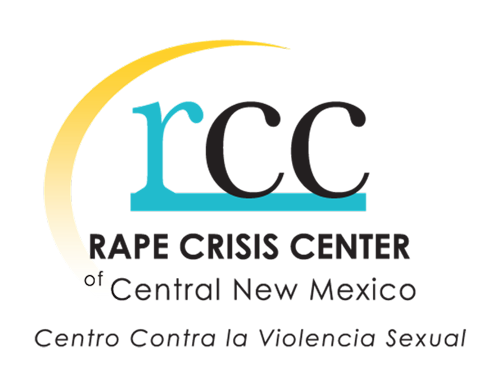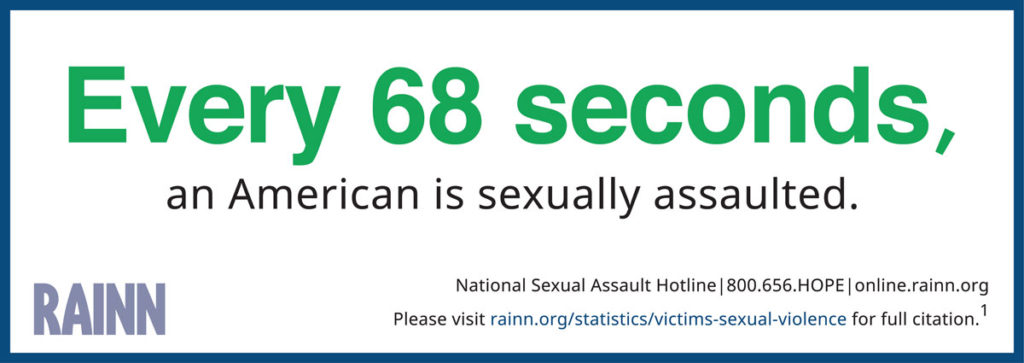

There is a number of resources available to you and our community for understanding sexual violence both nationally as well as in the state of New Mexico. Below are some sources of information, statistics, and resources available to you. Talking about sexual violence can be hard, so we’ve put together a resource to help with common phrases and words to use and avoid when talking about sexual violence. These are links that will connect you to other community partners that we work with for meeting the needs of anyone who has been affected by sexual violence in our communities. Part of understanding sexual violence is knowing how it affects our communities both nationally but also here in the state of New Mexico. You have a lot of questions and so want to answer them as best we can. We are here to help.
Sexual Violence is a non-legal term that refers to crimes like sexual assault, rape, and sexual abuse as well as other acts of violence that are verbal or emotional, such as coercion or catcalling.1

Understanding Sexual Violence as a Pyramid
Often times when we talk about sexual violence, we refer to it as something physical, like rape or sexual assault. However, sexual violence is more than that, it’s emotional, and psychological, and a lot of the time, it’s hard to see. The Sexual Violence Pyramid shows how language and things we might see as normal can create stereotypes that lead to violence. We can start to see where and how sexual violence starts so we can learn how to stop it from happening anymore.
Criminal versus Non-Criminal Sexual Violence
The term “sexual violence” is not a legal term but one that is used commonly by community organizations to describe any act of violence that is sexual. In New Mexico, however, there are a number of different legal terms for criminal sexual violence, which we have outlined here.
1 RAINN Types of Sexual Violence. RAINN 2016.
Sexual Violence Affects Millions of Americans
- On average, there are 463,634 victims (age 12 or older) of rape and sexual assault each year in the United States.1

Younger People Are at the Highest Risk of Sexual Violence
- Ages 12-34 are the highest risk years for rape and sexual assault.3
- Those age 65 and older are 92% less likely than 12-24 year olds to be a victim of rape or sexual assault, and 83% less likely than 25-49 year olds.4

Women and Girls Experience Sexual Violence at High Rates
Millions of women in the United States have experienced rape.
- As of 1998, an estimated 17.7 million American women had been victims of attempted or completed rape.5
Young women are especially at risk.
- 82% of all juvenile victims are female. 90% of adult rape victims are female.6
- Females ages 16-19 are 4 times more likely than the general population to be victims of rape, attempted rape, or sexual assault.3
- Women ages 18-24 who are college students are 3 times more likely than women in general to experience sexual violence. Females of the same age who are not enrolled in college are 4 times more likely.7
Men and Boys Are Also Affected by Sexual Violence

Millions of men in the United States have been victims of rape.
- As of 1998, 2.78 million men in the U.S. had been victims of attempted or completed rape.5
- About 3% of American men—or 1 in 33—have experienced an attempted or completed rape in their lifetime.5
- 1 out of every 10 rape victims are male.8
Sexual Violence Can Have Long-Term Effects on Victims
The likelihood that a person suffers suicidal or depressive thoughts increases after sexual violence.
- 94% of women who are raped experience symptoms of post-traumatic stress disorder (PTSD) during the two weeks following the rape.9
- 30% of women report symptoms of PTSD 9 months after the rape.10
- 33% of women who are raped contemplate suicide.11
- 13% of women who are raped attempt suicide.11
- Approximately 70% of rape or sexual assault victims experience moderate to severe distress, a larger percentage than for any other violent crime.12
People who have been sexually assaulted are more likely to use drugs than the general public.11
- 3.4 times more likely to use marijuana
- 6 times more likely to use cocaine
- 10 times more likely to use other major drugs
Sexual violence also affects victims’ relationships with their family, friends, and co-workers.12
- 38% of victims of sexual violence experience work or school problems, which can include significant problems with a boss, coworker, or peer.
- 37% experience family/friend problems, including getting into arguments more frequently than before, not feeling able to trust their family/friends, or not feeling as close to them as before the crime.
- 84% of survivors who were victimized by an intimate partner experience professional or emotional issues, including moderate to severe distress, or increased problems at work or school.
- 79% of survivors who were victimized by a family member, close friend or acquaintance experience professional or emotional issues, including moderate to severe distress, or increased problems at work or school.
- 67% of survivors who were victimized by a stranger experience professional or emotional issues, including moderate to severe distress, or increased problems at work or school.
Victims are at risk of pregnancy and sexually transmitted infections (STIs).
- Studies suggest that the chance of getting pregnant from one-time, unprotected intercourse is between 3.1-5%13, depending on a multitude of factors, including the time of month intercourse occurs, whether contraceptives are used, and the age of the female. The average number of rapes and sexual assaults against females of childbearing age is approximately 250,000.1 Thus, the number of children conceived from rape each year in the United States might range from 7,750—12,500.12 This is a very general estimate, and the actual number may differ. This statistic presents information from a number of different studies. Further, this information may not take into account factors which increase or decrease the likelihood of pregnancy, including, but not limited to: impact of birth control or condom use at the time of attack or infertility. RAINN presents this data for educational purposes only, and strongly recommends using the citations to review sources for more information and detail.
Sources:
- Department of Justice, Office of Justice Programs, Bureau of Justice Statistics, National Crime Victimization Survey, 2019 (2020). Note: RAINN applies a 5-year rolling average to adjust for changes in the year-to-year NCVS survey data.
- i. Department of Justice, Office of Justice Programs, Bureau of Justice Statistics, Sex Offenses and Offenders (1997); ii. Department of Justice, Office of Justice Programs, Bureau of Justice Statistics, Crimes Against the Elderly, 2003-2013 (2014).
- Department of Justice, Office of Justice Programs, Bureau of Justice Statistics, Sex Offenses and Offenders (1997).
- Department of Justice, Office of Justice Programs, Bureau of Justice Statistics, Crimes Against the Elderly, 2003-2013 (2014).
- National Institute of Justice & Centers for Disease Control & Prevention, Prevalence, Incidence and Consequences of Violence Against Women Survey (1998). (Statistic presents information on the total number of male and female victims in the United States, using a study from 1998. Because the U.S. population has increased substantially since then, it is probable that the number of victims has, as well. RAINN presents this data for educational purposes only, and strongly recommends using the citations to review any and all sources for more information and detail.)
- Department of Justice, Office of Justice Programs, Bureau of Justice Statistics, Sexual Assault of Young Children as Reported to Law Enforcement (2000).
- Department of Justice, Office of Justice Programs, Bureau of Justice Statistics, Rape and Sexual Victimization Among College-Aged Females, 1995-2013 (2014).
- Department of Justice, Office of Justice Programs, Bureau of Justice Statistics, Female Victims of Sexual Violence, 1994-2010 (2013).
- D.S. Riggs, T. Murdock, W. Walsh, A prospective examination of post-traumatic stress disorder in rape victims. Journal of Traumatic Stress 455-475 (1992).
- J. R. T. Davidson & E. B. Foa (Eds.) Posttraumatic Stress Disorder: DSM-IV and Beyond. American Psychiatric Press: Washington, DC. (pp. 23-36).
- DG Kilpatrick, CN Edumuds, AK Seymour. Rape in America: A Report to the Nation. Arlington, VA: National Victim Center and Medical University of South Carolina (1992).
- Department of Justice, Office of Justice Programs, Bureau of Justice Statistics, Socio-emotional Impact of Violent Crime (2014).
- Allen J. Wilcox, David B. Dunson, Clarice R. Weinberg, James Trussell, and Donna Day Baird, Likelihood of Contraception with a Single Act of Intercourse: Providing Benchmark Rates for Assessment of Post-Coital Contraceptives, Contraception Journal, (2001).
- Department of Justice, Office of Justice Programs, Bureau of Justice Statistics, American Indians and Crime, 1992-2002 (2004).
- Department of Justice, Office of Justice Programs, Bureau of Justice Statistics, Sexual Victimization in Prisons and Jails Reported by Inmates, 2011-2012 (2013).
- Department of Defense, Fiscal Year 2019 Annual Report on Sexual Assault in the Military, (2020).
- David Cantor, Bonnie Fisher, Susan Chibnall, Reanna Townsend, et. al. Association of American Universities (AAU), Report on the AAU Campus Climate Survey on Sexual Assault and Sexual Misconduct (September 21, 2015). (“Victim services agency” is defined in this study as a “public or privately funded organization that provides victims with support and services to aid their recovery, offer protection, guide them through the criminal justice process, and assist with obtaining restitution.” RAINN presents this data for educational purposes only, and strongly recommends using the citations to review any and all sources for more information and detail.)
Deaf & Hard of Hearing Services
Community Outreach Program for the Deaf
Differently-Abled Services
General Resources
Albuquerque Family Advocacy Center
University of New Mexico Women’s Resource Center
Health & Reproductive Rights
New Mexico AIDS Services (NMAS)
New Mexico Department of Health Sexual Violence Services and Prevention
UNM Women’s Resource Center (Crisis intervention and counseling)
Services for Children
New Mexico Children, Youth and Families Department Protective Services
Para Los Niños (University of New Mexico Hospital sexual assault services for infants and children)
Visually Impaired Services
Hotlines
Agora Crisis Line 505-277-3013
New Mexico Crisis Line (Hablan Español)
Legal Assistance
American Civil Liberties Union (ACLU)
Crime Victims Reparations Commission (CVRC)
Pegasus (Legal services for children)
Sexual Assault Information & Research
Abuse, Rape & Domestic Violence Aid & Resource Collection
Minnesota Center Against Violence & Abuse
National Domestic Violence Hotline
New Mexico Coalition of Sexual Assault Programs
Pennsylvania Coalition Against Rape
Rape Abuse & Incest National Network (RAINN)
Trauma Center at Justice Resource Institute
The Rape Crisis Center of Central New Mexico (RCCCNM) changed its name from the Albuquerque Rape Crisis Center in order to better reflect our scope of services. We serve Bernalillo, Sandoval, Torrance, and Valencia counties. Please contact us for more information, even if you’re not in our area! Anyone can call our 24-hour hotline, regardless of geographical location.
Every year, on average, our 24-hour hotline receives approximately 2,000 calls and we see close to 600 people at the SANE unit.
The Counseling department sees, on average, 275 new clients per year, as well as ongoing clients and group therapy participants.
The Community Education and Outreach department contacts, on average 13,000 community members per year.
What happened to you was not your fault. Whatever you did to survive the attack was the right thing to do. Please remember that you have options and support. You can call our 24-hour hotline to speak with a trained Advocate about how you are feeling and what your options are.
You can read more information about our Counseling department. Or, you can contact our offices during business hours (Monday – Friday, 8 am – 5 pm) and ask about coming in for Counseling.
Absolutely! It is very common for survivors to not fully be able to understand what happened to them or how they feel about it, especially if it doesn’t match up with the concept they had in their head about what would or would not be a violation.
Often it is hard for people to understand that physical violence is not always used in sexual assaults. The assault itself is still considered an act of violence.
It is important to understand that any sort of unwanted sexual encounters or unwanted sexualized actions taken towards you are sexual violations.
- Fear and overwhelming emotions occur as a result of having someone control your body.
- The offender may actually act affectionately once the victim is sufficiently under their control and may force the victim to speak and act affectionately towards them.
- During incidents of sexual violation, victims may feel that their body has betrayed them — their reactions to the abuse seem to contradict what they actually want. These events may make the survivor question whether an assault really happened.
Sexual assaults and violations, whether you experienced them as a child or as an adult, are often life-threatening experiences. No matter how you reacted to the violation, it was the right thing to do. No matter how you survived, it was the right thing to do. Sometimes this is hard for survivors to believe and it will be an important issue to address in counseling.
Counseling is a safe and helpful way to explore your feelings and reactions about the particular sexual violations you have experienced.
We believe that the prevention of sexual assault is possible through educational programs and outreach efforts. To that end, Community Education and Outreach provides education and training on sexual assault and other issues that affect violence in our communities. Presentations and trainings are available for youth, professional staff, community groups and others who are interested. All presentations can be modified to individual needs, so don’t be afraid to ask!
Sexual violence is any kind of unwanted sexual behavior. This can include verbal harassment, rape, sexual abuse, incest, and sexual assault. Sexual violence is something that affects many people.
In this world, most of us are survivors of something. At RCCCNM, we use the word “survivor”, rather than “victim”, to describe someone who has survived sexual violence. However, we support the right of all people to choose how they identify. Some people choose to identify as a victim or a different term, and that’s OK. We believe people when they self-identify as a survivor, victim, or any other word without questioning or doubting the experiences behind that choice.
Rape is defined as unwanted penetration, whether that is oral, anal, or vaginal. Sexual assault refers to any unwanted sexual contact, including fondling and molestation.
Sexual assault is a persistent social problem. In the United States in 2014, there were 284,350 survivors of rape, attempted rape, or sexual assault. A sexual assault takes place about every 30 seconds.
24-Hour Hotline 505-266-7711
Puede llamar 24 horas. Se habla Español



